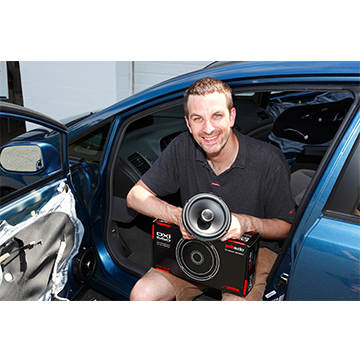A car stereo installation is an essential process that many car owners go through. Having a good car stereo system can enhance your driving experience and make long drives more enjoyable. In this article, we will discuss the ultimate electronics car stereo installation process that can help you achieve the best sound quality and provide you with a comprehensive guide to ensure a smooth and successful installation.
Before starting, it’s crucial to understand that the process of car stereo installation may vary depending on your vehicle model and stereo system. However, we will discuss the universal steps that you can follow to install a car stereo in most vehicles.
Step 1: Choosing the Right Car Stereo System
Before beginning the installation process, you need to choose the right car stereo system that suits your preferences and budget. There are several types of car stereo systems available in the market, including single-DIN and double-DIN.
Single-DIN stereo systems are the standard size and are usually less expensive than double-DIN systems. On the other hand, double-DIN systems are more extensive and provide more advanced features, such as touchscreen displays, GPS navigation, and Bluetooth connectivity.
Other factors to consider when choosing a car stereo system include sound quality, power output, and compatibility with your vehicle’s existing electronics system. You should also consider the type of music you listen to and your car’s acoustics to select the right speakers and amplifiers.
Step 2: Gather the Necessary Tools and Materials
Once you have selected the right car stereo system, it’s time to gather the necessary tools and materials for the installation process. Some of the tools you may need include wire strippers, crimping pliers, a soldering iron, screwdrivers, and a socket set.
You may also need additional materials such as wiring harness adapters, dash kits, and mounting brackets, depending on the type of car stereo system you have chosen.
Step 3: Disconnecting the Existing Stereo System
Before installing the new car stereo system, you need to disconnect the existing stereo system. To do this, start by removing the negative terminal of the car battery to prevent any electrical accidents.
Next, remove the dash panels that surround the stereo system. Depending on your vehicle model, you may need to remove screws or use a trim removal tool to pop off the panels. Be sure to keep the screws and other parts in a safe place to avoid losing them.
Once you have removed the dash panels, you can access the stereo system’s wiring harness. Carefully disconnect the wiring harness and antenna from the stereo system, taking note of which wire is connected to which port.
Step 4: Wiring the New Stereo System
After disconnecting the existing stereo system, you can now wire the new car stereo system. The wiring process may vary depending on your vehicle model and the type of stereo system you have chosen. However, most car stereo systems come with a wiring diagram that provides instructions on how to connect the wires correctly.
Start by connecting the wiring harness adapter to the new stereo system. Next, connect the wires from the adapter to the corresponding wires in your vehicle’s wiring harness, using crimp connectors or soldering iron to ensure a secure connection.
You may also need to connect additional wires, such as those for power and ground, amplifier remote turn-on, and steering wheel controls, depending on your stereo system’s features.
Step 5: Installing the New Stereo System
Once you have wired the new stereo system, it’s time to install it into your vehicle. Begin by inserting the new stereo system into the dash opening, making sure it fits snugly and securely.
Next, connect the stereo system’s wiring harness and antenna to the corresponding ports in your vehicle’s wiring harness. Finally, reattach the dash panels that surround the stereo system, making sure all screws and clips are secure.
Step 6: Testing the New Stereo System
After installing the new stereo system, it’s crucial to test it to ensure that it works correctly. Reconnect the negative terminal of the car battery and turn on the ignition to check if the new stereo system powers on.
Check the sound quality by playing music and adjusting the settings on the stereo system. Make sure that all the speakers are working correctly and that the sound quality is clear and balanced. If you notice any issues, such as distorted sound or low volume, check the wiring and connections to identify and resolve the problem.
Step 7: Customizing the Installation
After installing the new stereo system, you can customize the installation to your preferences. You can install additional components, such as subwoofers, amplifiers, and tweeters, to enhance the sound quality further.
You can also install dash kits and mounting brackets to improve the aesthetic of the installation and make it look more professional. These accessories can help to cover up any gaps or holes in the dash and provide a secure mount for the new stereo system.
Step 8: Maintenance and Upkeep
To ensure that your new car stereo system works correctly and lasts for a long time, it’s crucial to maintain and upkeep it regularly. This includes cleaning the components, checking the wiring and connections, and replacing any faulty parts promptly.
You should also avoid exposing the stereo system to extreme temperatures, humidity, and moisture, as this can damage the electronic components and reduce their lifespan. Finally, always follow the manufacturer’s instructions and guidelines for maintenance and upkeep to avoid damaging the stereo system and voiding the warranty.
Conclusion
Installing a new car stereo system can enhance your driving experience and provide you with better sound quality and advanced features. By following the steps outlined in this article, you can achieve the ultimate electronics car stereo installation and ensure a smooth and successful process.
Remember to choose the right car stereo system, gather the necessary tools and materials, disconnect the existing stereo system, wire the new stereo system correctly, install it securely, test the sound quality, customize the installation, and maintain and upkeep the stereo system regularly.
With these steps, you can enjoy a high-quality audio experience while driving and make long drives more enjoyable and comfortable.



